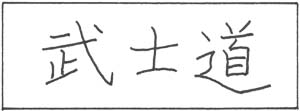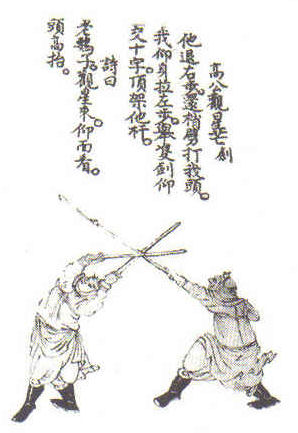|

Yung: Courage Along the Warrior Way
By Allen Pittman
with additional material by Brenda Sutton

The bushi is the warrior; do means "way" or "path". The idiogram for do is the picture of a foot. This term Bushido implies the way that a Japanese warrior walks on the path. The bushi had a rigid protocal of how to walk, to dress, to behave with senior and junior warriors. They maintained an impeccable social hierarchy. Their lives were dictated by protocol, where even death was considered an art. Because of the strict and refined social behaviour in Japan of the last few centuries prior to World War II, the passions of the warrior class found expression in incredibly refined poetry, painting, as well as combat art — craftsmanship squeezed like nectar from the flower—repression heating the alchemical athenor.
 The concept of Bushido is directly related to loyalty to the leader. The Japanese legend of
The Forty-seven Ronin celebrates a large group of samurai warriors who die attempting to avenge the death of their master. Based on a true incident from 1701, the loyal retainers of Lord Asano were given their freedom with a loss of reputation suffered when their lord was wrongly forced to commit seppuku, ritual suicide by self-disembowelment. Instead, the men chose to seek vengeance and restore honor to their clan. The loss of face caused by the death of their lord was more than they could endure. These ronin (masterless wave men) sought revenge after staging a two-year public façade of poverty and drunken, unruly behaviour. In the end, the ronin beheaded the corrupt court official who had been responsible for their Lord's death. The forty-seven paid homage at Lord Asano's grave, and then turned themselves in for court martial. The punishments of imprisonment or execution would have been considered disgraceful. Because of their commitment to bushido, all forty-seven men were grateful to receive the privilege of committing seppuku. They were buried with their lord at a temple called Sengaku-ji located just outside of Tokyo. The forty-seven ronin are considered acurate symbols of Bushido, immortalized in song, story, poetry, and some 37 films. Their deaths have been reenacted annually for over 300 years in their village of Ako. The concept of Bushido is directly related to loyalty to the leader. The Japanese legend of
The Forty-seven Ronin celebrates a large group of samurai warriors who die attempting to avenge the death of their master. Based on a true incident from 1701, the loyal retainers of Lord Asano were given their freedom with a loss of reputation suffered when their lord was wrongly forced to commit seppuku, ritual suicide by self-disembowelment. Instead, the men chose to seek vengeance and restore honor to their clan. The loss of face caused by the death of their lord was more than they could endure. These ronin (masterless wave men) sought revenge after staging a two-year public façade of poverty and drunken, unruly behaviour. In the end, the ronin beheaded the corrupt court official who had been responsible for their Lord's death. The forty-seven paid homage at Lord Asano's grave, and then turned themselves in for court martial. The punishments of imprisonment or execution would have been considered disgraceful. Because of their commitment to bushido, all forty-seven men were grateful to receive the privilege of committing seppuku. They were buried with their lord at a temple called Sengaku-ji located just outside of Tokyo. The forty-seven ronin are considered acurate symbols of Bushido, immortalized in song, story, poetry, and some 37 films. Their deaths have been reenacted annually for over 300 years in their village of Ako.
The Chinese culture includes a similar concept called Wu De that translates as "martial virtue." The difference between the Japanese Bushido and the Chinese Wu De is that the Japanese concept is caste related. Only a samurai can demonstrate Bushido. Bushido is a very militant archetype, and is also deeply intertwined with sepuku (ritualized suicide for the cause due to failure). In the Chinese concept of martial virtue, an artisan or a troubador, a poet or a warrior can demonstrate martial virtue by their loyalty to their friends, who may or may not be socially acceptable. The Japanese concept is class and gender specific. The Chinese concept is much more flexible, transcending social classes and gender.
Bushido is characterized by willingness to die; Wu De is characterized by willingness to sacrifice. In the Asian culture, one might die to "save face". The practitioner of Wu De would be willing to undergo public humiliation to save friends.
 teaches a Samurai.jpg)
More on "Courage":
Return to Mythic Passages Menu
Subscribe to the Mythic Passages e-magazine
|

